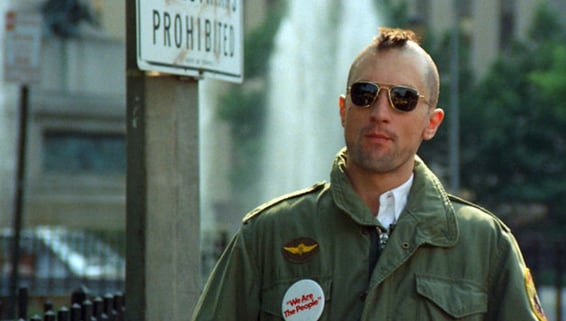The Lonely Symphony of a City’s Shadows: A Deep Dive into Taxi Driver
Cinemapedia
Martin Scorsese’s Taxi Driver (1976) stands as a timeless masterpiece that captures the haunting isolation and moral decay of urban life. With its stunning visuals, harrowing narrative, evocative music, and profound moral undertones, the film takes its audience on an unforgettable journey through the fractured mind of a man alienated from the world around him. This is not just a movie—it is a portrait of loneliness, disillusionment, and the dark underbelly of society.
A City Drenched in Neon and Shadows
Visually, Taxi Driver is a symphony of contrasts—gritty and dreamlike, bleak and vibrant. Cinematographer Michael Chapman masterfully captures the grimy streets of 1970s New York City, transforming the urban sprawl into a character of its own. The city is depicted as a living, breathing entity, pulsing with neon lights, rain-slicked streets, and suffocating shadows. The visuals evoke a sense of entrapment, mirroring the psychological turmoil of its protagonist, Travis Bickle (Robert De Niro).
The film’s use of color is particularly striking, with the glowing reds and greens of the city lights casting an eerie, almost surreal glow over the streets. Scorsese’s meticulous framing and Chapman’s dynamic camera movements pull the audience into Travis’ warped perspective, creating a visual language that is both unsettling and captivating. From the claustrophobic interiors of Travis’ taxi to the chaotic streets he roams, every frame feels deliberate, dripping with tension and unease.
A Descent into Alienation and Obsession
At its core, Taxi Driver is the story of Travis Bickle, a Vietnam War veteran who works as a taxi driver in New York City. Plagued by insomnia and disillusionment, Travis becomes increasingly disconnected from society, perceiving the city around him as a cesspool of crime and moral decay. His loneliness and resentment drive him into a downward spiral, culminating in a violent quest for redemption.
The narrative is a slow burn, meticulously unraveling Travis’ psyche as he drifts further from reality. His interactions with others—whether it’s his awkward infatuation with Betsy (Cybill Shepherd), a campaign worker, or his paternalistic concern for Iris (Jodie Foster), a teenage prostitute—highlight his inability to connect with those around him. The story is not just about Travis’ descent into madness but also a critique of the societal structures that breed such alienation.
Scorsese and screenwriter Paul Schrader craft a narrative that is both deeply personal and universally resonant, exploring themes of loneliness, violence, and the search for meaning in a fractured world. Travis’ infamous declaration, “You talkin’ to me?”, is not just a line—it’s a reflection of his growing detachment and simmering rage.
A Melancholic and Menacing Symphony
The score by Bernard Herrmann, in what would be his final composition, is a haunting blend of melancholy and menace. The sultry saxophone theme captures the loneliness and yearning that define Travis’ existence, while the pulsating, almost militaristic percussion underscores his growing volatility and sense of purpose. Herrmann’s music becomes a character in itself, mirroring Travis’ internal conflict and the oppressive atmosphere of the city.
The contrast between the lush romanticism of the saxophone and the ominous undercurrents of the score reflects the duality of Travis’ character—his yearning for connection and his descent into violence. The music lingers long after the film ends, a haunting reminder of the psychological and emotional depths the story explores.
A Mirror to Society’s Shadows
Taxi Driver is a film steeped in moral ambiguity, forcing its audience to grapple with uncomfortable questions about morality, violence, and the human condition. At its heart, the film is a meditation on loneliness and alienation in a world that often seems indifferent to the struggles of the individual.
Travis’ actions, while born out of a twisted sense of justice, blur the line between heroism and vigilantism. His descent into violence is both a critique of societal neglect and a reflection of his own fractured psyche. The film challenges the audience to question whether Travis is a product of his environment or a cautionary tale about the dangers of unchecked isolation and disillusionment.
Scorsese does not offer easy answers or moral resolutions. Instead, Taxi Driver serves as a mirror, reflecting the darkness that can fester within individuals and society alike. It is a film that demands introspection, forcing its audience to confront the shadows within themselves and the world around them.
A Timeless Portrait of Isolation and Madness
Taxi Driver is more than just a film—it is an experience, a journey into the depths of human loneliness and the moral complexities of modern life. With its stunning visuals, haunting music, and deeply layered narrative, the film remains as relevant today as it was upon its release. Scorsese and De Niro craft a character and a story that linger in the mind, challenging the audience to look beyond the surface and confront the darker truths of existence.
In the end, Taxi Driver is not just about Travis Bickle—it is about all of us, our struggles, our desires, and our fears. It is a film that does not shy away from the shadows, instead illuminating them with an unflinching gaze. As the taxi glides through the neon-lit streets, Taxi Driver leaves its audience with a lingering sense of unease and a profound understanding of the human condition.


